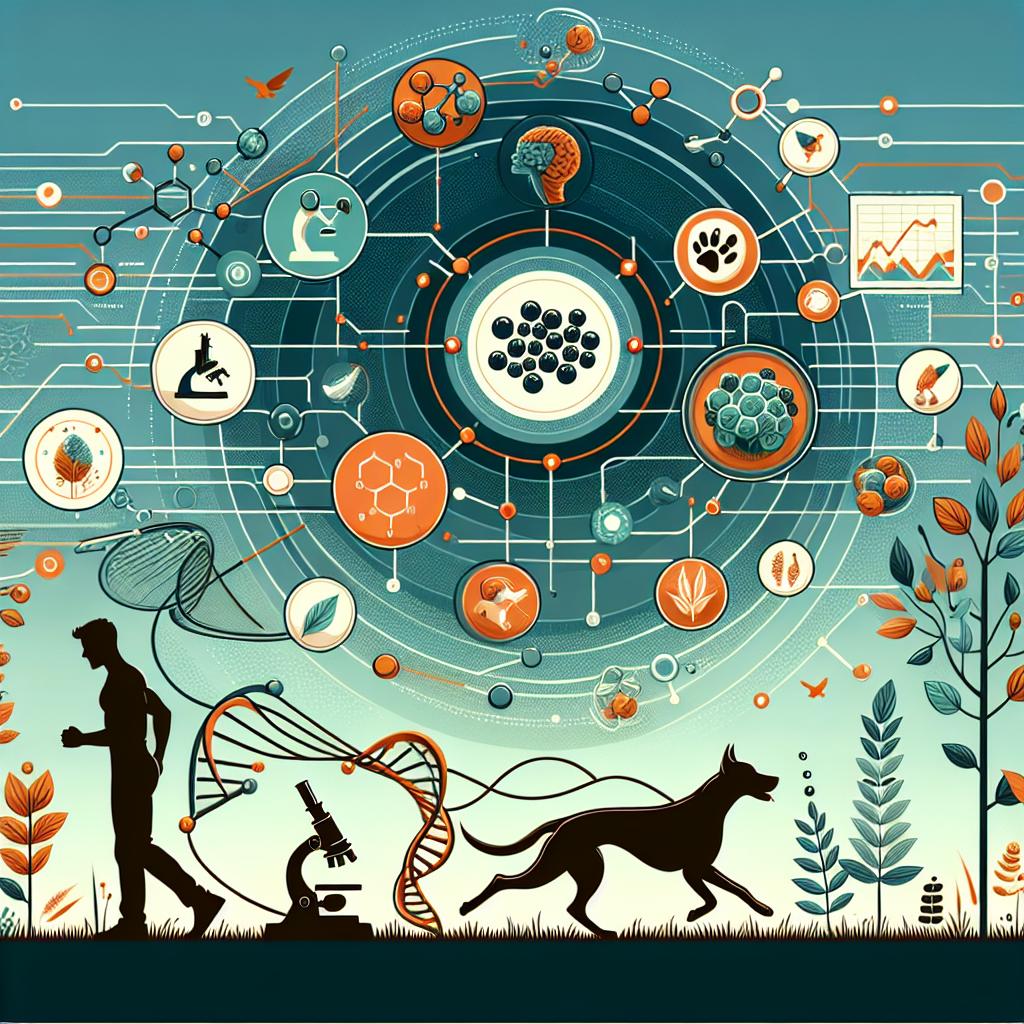When we think of providing the best for our beloved canine companions, we often focus on the basics: tasty meals, bowls brimming with kibble, and the occasional treat. Yet, nestled within these everyday rituals lies a critical element that profoundly impacts our dogs’ health and longevity—protein quality. Just as the foundation of a well-constructed building determines its stability, the quality of protein in dog food is essential for fortifying a dog’s overall well-being. In a marketplace overflowing with pet food options, understanding the nuances of protein sources can transform mere nourishment into optimal health. This article delves into the importance of protein quality in dog food, exploring how the right choices can help our four-legged friends thrive, support their active lifestyles, and safeguard them against various health issues. Join us as we unravel the essential role of protein, guiding dog owners towards informed decisions for their furry family members.
Understanding Protein Quality and Its Impact on Canine Health
When assessing the quality of protein in dog food, it’s crucial to consider the source and its biological value. High-quality proteins are typically derived from animal sources such as chicken, beef, fish, and eggs, which contain essential amino acids that can be easily absorbed by your dog’s body. In contrast, lower-quality proteins, often found in plant sources or by-products, might not provide the same level of amino acids, which can lead to deficiencies and impact overall health. This is why ensuring the presence of complete proteins in your dog’s diet is paramount.
Furthermore, protein quality can significantly influence various health outcomes in dogs. A diet rich in high-quality proteins can promote healthy muscle development, support immune function, and improve coat quality. Dogs fed lower-quality proteins may show signs of lethargy, poor skin health, and even gastrointestinal issues. To better understand the differences in protein sources, here’s a comparison of some common ingredients found in dog food:
| Protein Source | Amino Acid Profile | Digestibility |
|---|---|---|
| Chicken | Complete | Highly Digestible |
| Beef | Complete | Highly Digestible |
| Fish | Complete | Highly Digestible |
| Soy Protein | Incomplete | Moderately Digestible |
| Corn Gluten Meal | Incomplete | Low Digestibility |

Essential Amino Acids: The Building Blocks of a Balanced Diet
When it comes to canine nutrition, understanding the role of essential amino acids is key to ensuring your dog receives adequate protein quality. Amino acids are the fundamental building blocks of proteins, and among them, nine are considered essential because they cannot be synthesized by the dog’s body. This means that these amino acids must be obtained through diet. A well-rounded dog food should include sources that not only meet but exceed the basic protein requirements, providing a range of essential amino acids such as lysine, methionine, and tryptophan. These components contribute to various physiological functions, from muscle repair and growth to immune responses and hormone production.
To ensure that your dog is thriving on a balanced diet, look for food formulations that are rich in high-quality protein sources. Opting for foods that list whole meats, fish, or eggs as primary ingredients can make a significant difference. Here are some common sources of essential amino acids:
| Protein Source | Essential Amino Acids |
|---|---|
| Chicken | Lysine, Methionine, Threonine |
| Beef | Arginine, Leucine, Isoleucine |
| Fish | Tryptophan, Phenylalanine, Valine |
| Eggs | Cysteine, Histidine, Glycine |
Choosing a dog food that prioritizes protein quality not only enhances your pet’s health but also supports their overall vitality and energy levels. As you explore various options, remember that each dog has unique dietary needs based on their age, size, and activity level, making it essential to tailor their food choices accordingly.

Evaluating Protein Sources: What to Look for in Dog Food Labels
When scrutinizing dog food labels, it’s crucial to prioritize the quality of protein sources. Look for named animal proteins as the first ingredient, such as chicken meal, beef, or fish instead of vague terms like “meat by-products.” These specific descriptions not only indicate the source but also suggest a higher digestibility and nutritional value. Additionally, ensure that the protein content comes from multiple sources to provide a diverse amino acid profile; this can support overall health and well-being.
Moreover, consider the protein’s biological value, which reflects how efficiently the body utilizes it. Ingredients like whole meats, meat meals, and certain animal organs rank higher due to their nutrient density. Pay attention to the presence of digestible carbohydrates and healthy fats that work in synergy with proteins to enhance your dog’s nutrition. By examining these elements, you can select a dog food that not only meets the protein requirements but also promotes optimal health for your furry companion. To assist you further, here’s a simplified comparison of different protein sources:
| Protein Source | Biological Value | Benefits |
|---|---|---|
| Chicken | 79 | High digestibility, lean protein |
| Beef | 69 | Rich in iron, supports muscle growth |
| Fish | 76 | Omega-3 fatty acids, promotes a healthy coat |
| Eggs | 100 | Complete protein, highly digestible |

Tailoring Protein Intake: Meeting Your Dogs Unique Nutritional Needs
Understanding your dog’s specific protein needs is essential for their health and well-being. Factors such as age, breed, activity level, and any existing health conditions play a significant role in determining the right protein intake. For instance, puppies require a higher protein percentage to support their rapid growth, while older dogs may need easily digestible proteins to maintain muscle mass without taxing their digestive system. Each dog is unique, and tailoring their diet to meet these needs involves not only selecting the right protein sources but also ensuring they come from high-quality ingredients.
To help owners better manage their dogs’ protein needs, consider the following factors when choosing a dog food:
- Quality of Protein: Look for specific meat sources rather than generic terms like “meat meal.” Chicken, beef, and fish should be clearly identified.
- Protein Digestibility: Choose foods with a high digestibility rate, ensuring your dog absorbs essential amino acids efficiently.
- Balance with Other Nutrients: A well-rounded diet includes not only protein but also fats, carbohydrates, vitamins, and minerals to support overall health.
| Dog Type | Recommended Protein % |
|---|---|
| Puppy | 22-32% |
| Adult Active Dog | 18-25% |
| Senior Dog | 15-20% |
Q&A
Q&A: The Importance of Protein Quality in Dog Food
Q1: Why is protein essential for a dog’s diet?
A1: Protein is fundamental in a dog’s diet because it supports growth, muscle development, and overall health. Dogs use proteins to build and repair tissues, produce enzymes and hormones, and maintain a robust immune system. Think of protein as the building blocks that keep your furry friend strong and energetic!
Q2: What is meant by ‘protein quality’ in dog food?
A2: Protein quality refers to the composition and digestibility of the protein sources used in dog food. High-quality proteins provide all the essential amino acids that dogs need, while lower-quality proteins may not offer a complete profile or may be difficult for dogs to digest. When evaluating dog food, consider not just the amount of protein but its source and how well your dog can utilize it.
Q3: How can I identify high-quality proteins in dog food?
A3: To identify high-quality proteins, look for named meat sources listed as the first ingredients, such as chicken, beef, lamb, or fish. Additionally, review the labels for the type of meat—whole meats are preferable to meat meals, although certain meal types can also provide concentrated nutrition. Checking for the inclusion of animal by-products is crucial, as these can vary widely in quality.
Q4: Are plant-based proteins a good option for dogs?
A4: Plant-based proteins can be included in a dog’s diet but should not be the sole source. While they may provide some essential amino acids, they often lack one or more of the essential amino acids that dogs need for optimal health. A balanced diet that includes high-quality animal proteins alongside select plant proteins can be beneficial, especially for dogs with specific dietary needs.
Q5: How does protein quality affect a dog’s health?
A5: The quality of protein in a dog’s food can significantly impact their health. High-quality proteins help maintain a healthy weight, improve muscle tone, and enhance skin and coat condition. In contrast, low-quality proteins can lead to deficiencies, poor digestion, and various health issues, including obesity and skin problems. Ensuring a diet rich in high-quality protein is a step towards a longer, healthier life for your dog.
Q6: Can I trust brands that emphasize protein on their packaging?
A6: It’s essential to be a discerning consumer. While brands may highlight protein content on their packaging, it’s important to investigate the source and quality of that protein. Look beyond the marketing jargon; read ingredient lists and nutritional profiles, and consider reaching out to pet food forums or discussions for firsthand experiences with specific brands.
Q7: Should protein intake vary by dog breed or age?
A7: Absolutely! Different breeds and life stages have varying protein requirements. Puppies require more protein for growth, while active adult dogs need ample protein to support their energy levels. Senior dogs may benefit from a balanced protein intake that supports muscle retention without overburdening their kidneys. Consulting with a veterinarian can help tailor dietary choices to suit your dog’s specific needs.
Q8: How can I ensure my dog receives a balanced diet with high-quality protein?
A8: Start by selecting a reputable dog food brand that prioritizes high-quality protein sources. Incorporate a variety of proteins to create a diverse diet, and consider supplementing with whole food options, like cooked lean meats or fish, in moderation. Regular veterinary check-ups will help ensure that your dog’s diet aligns with their health requirements and lifestyle.
Q9: What role does protein play in special dietary needs for dogs?
A9: For dogs with special dietary needs—such as food allergies, sensitivities, or metabolic conditions—protein quality becomes even more critical. In such cases, choosing single-source, novel proteins or prescription diets recommended by a veterinarian can help manage their health conditions while ensuring they receive adequate nutrition.
Q10: What’s the bottom line when it comes to protein quality in dog food?
A10: The bottom line is that protein quality matters! Prioritizing high-quality protein in your dog’s diet promotes their health and vitality. It’s a crucial investment in their well-being that pays off in energy levels, physical condition, and overall happiness. Always aim for balanced nutrition tailored to your dog’s unique needs, and don’t hesitate to consult with professionals as needed. Your furry companion deserves the best!
The Conclusion
the quality of protein in your dog’s food is not just a matter of nutrition; it’s a cornerstone of their overall health and vitality. As guardians of our furry companions, it is our responsibility to ensure they receive the essential building blocks needed for a active and happy life. By prioritizing high-quality protein sources, we can support their muscle development, immune function, and energy levels, allowing them to thrive. As you navigate the myriad of choices in the pet food aisle, remember that understanding the protein content and its source can make all the difference in your dog’s well-being. After all, a well-fed dog is not just a healthy dog; it’s a happier, more energetic companion ready to face the world at your side. So, choose wisely, and let the quality of their food reflect the love and care you have for them.

